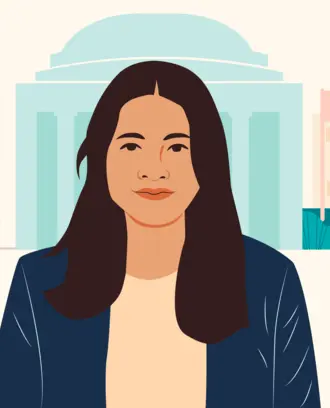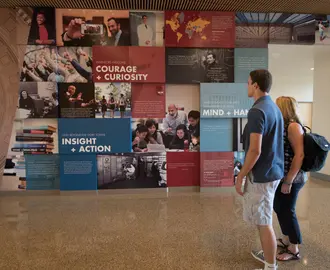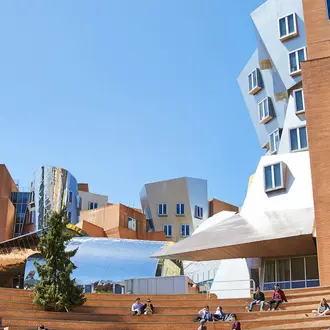Born in Jamaica and raised in New York, Britt Chong, MBA ’22 is the definition of a go-getter. As an undergraduate at Amherst College, she was a pre-med track with a major in Asian Languages and Civilizations and a concentration in Mandarin. From the start of her career as a social worker supporting chronically ill and impoverished patients in NYC, to helping small business owners and immigrants access emergency capital, and finally as a management consultant at Deloitte, Britt has explored many facets of entrepreneurship. Her goal has always been to find alternative solutions to the socioeconomic burdens that affect many underrepresented minority communities. With an innate passion for building things and an entrepreneurial drive for innovating solutions, Britt has taken full advantage of her time in the MBA program at Sloan and is now immersed in her startup WiRa.
Britt Chong, MBA '22
What were you doing before Sloan?
I was working in financial services focused primarily on supporting small business owners in gaining access to money that they wouldn’t otherwise be able to get. This was largely due to the fact that they were immigrants, had poor credit, or just weren’t the model candidate for a traditional bank loan.
Then I moved on to management consulting at Deloitte, where I developed products using immersive technology like virtual, augmented, and mixed reality for enterprise solutions. In my last year at Deloitte, I led the design and development of two products in this space, and was able to raise collectively $550,000 for those projects. I was hooked on building meaningful tools from ideation to launch. Even during my core semester at Sloan, I was still working at Deloitte trying to make sure that the final project had a strong launch. We were able to get a Fortune 100 client to pilot it with us and develop a good sales pipeline.
What made you want to come to Sloan?
MIT Sloan was my school of choice, my dream school. The innovation community here is unparalleled. I was looking at other MBA programs that were leaders in tech and innovation, and I created a very detailed spreadsheet. When I looked at my final choices, there wasn’t even a question—MIT had the perfect combination of access to academics spearheading their field, Media Lab researchers exploring the unknown, and the community fervor to invent things and see what happens. I’d been searching for that and would find it in pockets of my personal life, but had never found it in a professional community.
When I looked at the leaders in entrepreneurship at other leading business schools, I just didn’t find that hunger for innovation, combined with the humility that I was raised with, and the relatable, self-effacing, open curiosity. Everywhere else, the impression I got was very much a means to an end, as opposed to a lifestyle. And this is really the shift that I’m trying to make in my career. I want to lead a life of impact, curiosity, and intention—and that’s the vibe that I get from my peers here at Sloan.
How did you come to launch your startup? What made you want to take that next step?
Throughout my career, I had been doing entrepreneurial things that I saw as spokes on a wheel—each one representing a different social determinant of health. When I was younger, I was focused on primary care and direct care. Then I started understanding the economic challenges, and later the structural and workplace challenges that people faced. I had previously studied and worked in China in a Traditional Chinese Medicine (TCM) hospital. So I was very passionate about integrative medicine—combining Eastern and Western medicine—and how we can give poor communities renewable tools to empower themselves.
I’m no one’s savior. In typical Jamaican form, I would much rather learn how to fish than be given one. So that was a guiding force for me. In trying to figure out how to help those communities, I focused on deepening intergenerational connections to expand individuals’ sense of perspective, and encouraging self-reliance. I continued in that vein of exploration, using entrepreneurship and alternative ways of helping folks teach themselves how to fish. But now, the biggest thing that I want to move forward with in my career is building tools that help communities take accountability for their role in climate change.
Given your experience in entrepreneurship, how has Sloan helped you in developing your startup?
At Sloan, I was able to start three different startups. The first one was ONA, a digital protest app that captured data from youth-led protests as sustainability analytics for enterprises. The second one, Two Breaths, was sparked by the Collaborative Machine Intelligence Competition at MIT. This Snapchat based tool used machine learning and augmented reality as an anxiety intervention for young people.
WiRa started when I joined the MEMSI Hardware Bootcamp in Hong Kong, and it’s what I’m focused on now. Initially, I saw a problem in waste management in Hong Kong that was impacting the poorest people in one of the wealthiest economies in the world. I’m hoping that WiRa can be one small piece of the solution for these communities. Right now, it’s a food sorter and an educational tool that provides analytics for food service operators. Down the line, it will be a digester and turn the food waste within the bin into biofuel that can be a renewable energy resource that actually stays in these communities.
How has the Sloan community shown up for you?
A friend suggested that I check out the MEMSI program at the Martin Trust Center for MIT Entrepreneurship. I quickly signed up and remember finishing my application while I was at the ROMBA (Reaching Out LGBTQ+ MBA) conference with my Sloanie friends, who were taking notes for me in between activities. It was completely a Sloan-driven process of friendship and community, pointing me in the direction of resources that I didn’t even know about, as plugged in as I tried to be. There was never somebody hiding resources because they didn’t want the competition.
I also got connected with an MIT alum and EE CS PhD, Dr. Joseph Hui, who is absolutely brilliant and has been an excellent mentor and advisor to me during the MEMSI program. He is a real visionary in terms of alternative energy forms and solutions for climate change. He shared his resources, opened himself up to collaboration with his many patents, and really guided me in challenging conventional views of smart cities and futurism.
Having this constant energy of people who are like “let’s go for it together” is what made WiRa what it is. I was raised in a certain way, so seeing that much food waste really frustrated me and was a trigger personally. But WiRa wouldn’t be what it is without all of the different points of contact that were allowing me to even have that opportunity once I was at MIT.
Speaking of community, how has your identity as a Black woman strengthened your conviction to innovate in this space?
The time here feels really precious. Working as a social worker, I’ve spent a lot of my time trying to solve structural racism and problems within institutions. At Sloan, I made a conscious decision to really focus on developing myself, and question the assumption that because I’m Brown I have to be at the helm of Brown justice.
In the same breath, I couldn’t help myself! So I started a project with some friends to redesign the Black Student Union lounge at MIT, which serves as the only place dedicated to undergraduate and graduate Black students. I wanted to make it a space that is for the work that we as people of color came here to do, and for us to celebrate one another and communicate without the omnipresent labor of explaining our experience. I came here just like everybody else––to hustle, and I am addressing my conviction to support the Black experience the best way I know how––building community and innovating spaces.
Any advice you would give to prospective students interested in making their own impact at Sloan?
I’ll pass on some advice that I received from another female entrepreneur in the fall. Take out a sticky note. Write down the top three things that you came here for. If you’re ever at a crossroads—“Do I do activity A or B? Do I engage with my friends and build community, or do I stay in and read through this very intense research paper?”—look at that sticky note. If it doesn’t hit one of those three things, then don’t do it.
This sticky note is a low-tech solution that’s been really helpful to me. I like tactical pieces of advice compared to philosophical ones. Change comes from the small choices that we make on any given day—and it’s the accumulation of those small choices that creates a behavioral change or gets you to a goal.
Register your interest to learn more about the MIT Sloan MBA Program.



